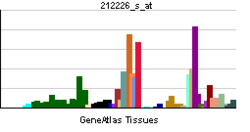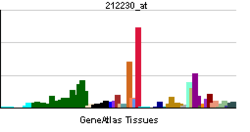PPAP2B
| View/Edit Human | View/Edit Mouse |
Lipid phosphate phosphohydrolase 3 (LPP3), also known as phospholipid phosphatase 3 (PLPP3) and phosphatidic acid phosphatase type 2B (PAP-2b or PPAP2B), is an enzyme that in humans is encoded by the PPAP2B gene on chromosome 1.[4][5][6] It is ubiquitously expressed in many tissues and cell types.[7] LPP3 is a cell-surface glycoprotein that hydrolyzes extracellular lysophosphatidic acid (LPA) and short-chain phosphatidic acid.[8] Its function allows it to regulate vascular and embryonic development by inhibiting LPA signaling, which is associated with a wide range of human diseases, including cardiovascular disease and cancer, as well as developmental defects.[9] The PPAP2B gene also contains one of 27 loci associated with increased risk of coronary artery disease.[10]
Structure
Gene
The PPAP2B gene resides on chromosome 1 at the band 1p32.2 and includes 6 exons.[5]
Protein
LPP3 is a member of the PAP-related phosphoesterase family.[6] It is a type 2 activity PAP, which localizes to the plasma membrane, and is one of four known LPP isoforms. As an integral membrane protein, LPP3 contains six hydrophobic transmembrane domains and a hydrophilic catalytic site composed of three conserved domains.[11][12] One catalytic domain is proposed to bind the substrate while the other two contribute to dephosphorylation of the substrate. The catalytic site typically faces the extracellular matrix when located on the cell membrane and faces the lumen when located in intracellular membranes. This protein can form homo- and hetero-oligomers.[12]
Function
This protein is a membrane glycoprotein localized at the cell plasma membrane. It has been shown to actively hydrolyze extracellular lysophosphatidic acid (LPA) and short-chain phosphatidic acid. [5] As an LPA inhibitor, PPAP2B is known to suppress LPA receptor mediated cellular signaling, which is associated with activation of vascular and blood cells and epithelial cell migration and proliferation.[13][14] In response to dynamic atherorelevant-flows, PPAP2B can promote anti-inflammatory phenotype via inhibition of LPA signaling and maintain vascular integrity of endothelial monolayer. This flow-sensitive PPAP2B expression is inhibited by microRNA-92a and activated by transcription factor KLF2.[15] In addition to LPA receptor-mediated signaling, PPAP2B is also associated with Wnt signaling, functioning in embryonic development for proper formation of important tissues including bone, heart and muscle. The phenotype of axis duplication in mice globally lacking PPAP2B resembles that observed in animals with altered Wnt signaling.[16] Furthermore, Wnt signaling mediated TCF/LEF-transcription via β-catenin is upregulated in PPAP2B null embryonic stem cells, implicating LPP3 as a negative regulator of the Wnt pathway.[17]
Clinical Significance
Due to the regulatory role of LPP3 in vascular and embryonic development, inactivation of this protein can contribute to cardiovascular disease and developmental complications. For example, inducible inactivation of LPP3 in both endothelial and hematopoietic cells leads to atherosclerosis due to accumulation of LPA in human plaques.[9][18] Likewise, plasma LPA levels are significantly elevated in patients with acute coronary syndromes.[19] It was further observed that reduced levels of endothelial LPP3 is associated with disturbed flow and mechano-regulation in blood vessels.[15] During embryonic development in mice, inactivation of LPP3 results in early lethality in part due to failure of extra-embryonic vascular development.[20] Abnormal activation of LPA signaling has also been implicated in cancer, fibrotic disorders, and metabolic syndrome (involving insulin resistance).[21][22]
Clinical Marker
In humans, PPAP2B emerged as 1 of 13 new loci associated with coronary artery disease by genome-wide association studies (GWAS).[23][24] Interestingly, this prediction appears to be independent of traditional risk factors for cardiovascular disease such as high cholesterol levels, high blood pressure, obesity, smoking, and diabetes mellitus.
Additionally, a multi-locus genetic risk score study, based on a combination of 27 loci including the PPAP2B gene, identified individuals at increased risk for both incident and recurrent coronary artery disease events, as well as an enhanced clinical benefit from statin therapy. The study was based on a community cohort study (the Malmo Diet and Cancer study) and four additional randomized controlled trials of primary prevention cohorts (JUPITER and ASCOT) and secondary prevention cohorts (CARE and PROVE IT-TIMI 22).[10]
Taken together, these findings also suggest that PPAP2B and LPA may serve a role in predicting and screening coronary artery disease for early prevention.[13]
Interactions
Interactive Pathway Map
LPP3 participates in interactions within the triacylglyceride synthesis and sphingolipid metabolism pathways.
References
- ↑ "Diseases that are genetically associated with PLPP3 view/edit references on wikidata".
- ↑ "Human PubMed Reference:".
- ↑ "Mouse PubMed Reference:".
- ↑ Kai M, Wada I, Imai Si, Sakane F, Kanoh H (September 1997). "Cloning and characterization of two human isozymes of Mg2+-independent phosphatidic acid phosphatase". The Journal of Biological Chemistry. 272 (39): 24572–8. doi:10.1074/jbc.272.39.24572. PMID 9305923.
- 1 2 "Entrez Gene: PPAP2B phosphatidic acid phosphatase type 2B".
- 1 2 "PLPP3 - Phospholipid phosphatase 3 - Homo sapiens (Human) - PLPP3 gene & protein". www.uniprot.org. Retrieved 2016-08-17.
- ↑ "BioGPS - your Gene Portal System". biogps.org. Retrieved 2016-08-17.
- ↑ Ishikawa T, Kai M, Wada I, Kanoh H (April 2000). "Cell surface activities of the human type 2b phosphatidic acid phosphatase". Journal of Biochemistry. 127 (4): 645–51. PMID 10739957.
- 1 2 Yung YC, Stoddard NC, Chun J (July 2014). "LPA receptor signaling: pharmacology, physiology, and pathophysiology". Journal of Lipid Research. 55 (7): 1192–214. doi:10.1194/jlr.R046458. PMC 4076099
 . PMID 24643338.
. PMID 24643338. - 1 2 Mega JL, Stitziel NO, Smith JG, Chasman DI, Caulfield MJ, Devlin JJ, Nordio F, Hyde CL, Cannon CP, Sacks FM, Poulter NR, Sever PS, Ridker PM, Braunwald E, Melander O, Kathiresan S, Sabatine MS (June 2015). "Genetic risk, coronary heart disease events, and the clinical benefit of statin therapy: an analysis of primary and secondary prevention trials". Lancet. 385 (9984): 2264–71. doi:10.1016/S0140-6736(14)61730-X. PMC 4608367
 . PMID 25748612.
. PMID 25748612. - ↑ Roberts R, Sciorra VA, Morris AJ (August 1998). "Human type 2 phosphatidic acid phosphohydrolases. Substrate specificity of the type 2a, 2b, and 2c enzymes and cell surface activity of the 2a isoform". The Journal of Biological Chemistry. 273 (34): 22059–67. doi:10.1074/jbc.273.34.22059. PMID 9705349.
- 1 2 Long JS, Pyne NJ, Pyne S (April 2008). "Lipid phosphate phosphatases form homo- and hetero-oligomers: catalytic competency, subcellular distribution and function". The Biochemical Journal. 411 (2): 371–7. doi:10.1042/BJ20071607. PMID 18215144.
- 1 2 Ren H, Panchatcharam M, Mueller P, Escalante-Alcalde D, Morris AJ, Smyth SS (January 2013). "Lipid phosphate phosphatase (LPP3) and vascular development". Biochimica et Biophysica Acta. 1831 (1): 126–32. doi:10.1016/j.bbalip.2012.07.012. PMC 3683602
 . PMID 22835522.
. PMID 22835522. - ↑ English D, Kovala AT, Welch Z, Harvey KA, Siddiqui RA, Brindley DN, Garcia JG (December 1999). "Induction of endothelial cell chemotaxis by sphingosine 1-phosphate and stabilization of endothelial monolayer barrier function by lysophosphatidic acid, potential mediators of hematopoietic angiogenesis". Journal of Hematotherapy & Stem Cell Research. 8 (6): 627–34. doi:10.1089/152581699319795. PMID 10645770.
- 1 2 Wu C, Huang RT, Kuo CH, Kumar S, Kim CW, Lin YC, Chen YJ, Birukova A, Birukov KG, Dulin NO, Civelek M, Lusis AJ, Loyer X, Tedgui A, Dai G, Jo H, Fang Y (July 2015). "Mechanosensitive PPAP2B Regulates Endothelial Responses to Atherorelevant Hemodynamic Forces". Circulation Research. 117 (4): e41–53. doi:10.1161/CIRCRESAHA.117.306457. PMC 4522239
 . PMID 26034042.
. PMID 26034042. - ↑ Escalante-Alcalde D, Hernandez L, Le Stunff H, Maeda R, Lee HS, Sciorra VA, Daar I, Spiegel S, Morris AJ, Stewart CL (October 2003). "The lipid phosphatase LPP3 regulates extra-embryonic vasculogenesis and axis patterning". Development. 130 (19): 4623–37. doi:10.1242/dev.00635. PMID 12925589.
- ↑ Arnold SJ, Stappert J, Bauer A, Kispert A, Herrmann BG, Kemler R (March 2000). "Brachyury is a target gene of the Wnt/beta-catenin signaling pathway". Mechanisms of Development. 91 (1-2): 249–58. PMID 10704849.
- ↑ Siess W, Zangl KJ, Essler M, Bauer M, Brandl R, Corrinth C, Bittman R, Tigyi G, Aepfelbacher M (June 1999). "Lysophosphatidic acid mediates the rapid activation of platelets and endothelial cells by mildly oxidized low density lipoprotein and accumulates in human atherosclerotic lesions". Proceedings of the National Academy of Sciences of the United States of America. 96 (12): 6931–6. PMC 22019
 . PMID 10359816.
. PMID 10359816. - ↑ Kurano M, Suzuki A, Inoue A, Tokuhara Y, Kano K, Matsumoto H, Igarashi K, Ohkawa R, Nakamura K, Dohi T, Miyauchi K, Daida H, Tsukamoto K, Ikeda H, Aoki J, Yatomi Y (February 2015). "Possible involvement of minor lysophospholipids in the increase in plasma lysophosphatidic acid in acute coronary syndrome". Arteriosclerosis, Thrombosis, and Vascular Biology. 35 (2): 463–70. doi:10.1161/ATVBAHA.114.304748. PMID 25425621.
- ↑ Escalante-Alcalde D, Hernandez L, Le Stunff H, Maeda R, Lee HS, Sciorra VA, Daar I, Spiegel S, Morris AJ, Stewart CL (October 2003). "The lipid phosphatase LPP3 regulates extra-embryonic vasculogenesis and axis patterning". Development. 130 (19): 4623–37. doi:10.1242/dev.00635. PMID 12925589.
- ↑ Evans JF, Hutchinson JH (July 2010). "Seeing the future of bioactive lipid drug targets". Nature Chemical Biology. 6 (7): 476–9. doi:10.1038/nchembio.394. PMID 20559310.
- ↑ Schober A, Siess W (October 2012). "Lysophosphatidic acid in atherosclerotic diseases". British Journal of Pharmacology. 167 (3): 465–82. doi:10.1111/j.1476-5381.2012.02021.x. PMC 3449253
 . PMID 22568609.
. PMID 22568609. - ↑ Schunkert H, König IR, Kathiresan S, Reilly MP, Assimes TL, Holm H, et al. (April 2011). "Large-scale association analysis identifies 13 new susceptibility loci for coronary artery disease". Nature Genetics. 43 (4): 333–8. doi:10.1038/ng.784. PMC 3119261
 . PMID 21378990.
. PMID 21378990. - ↑ Erbilgin A, Civelek M, Romanoski CE, Pan C, Hagopian R, Berliner JA, Lusis AJ (July 2013). "Identification of CAD candidate genes in GWAS loci and their expression in vascular cells". Journal of Lipid Research. 54 (7): 1894–905. doi:10.1194/jlr.M037085. PMC 3679391
 . PMID 23667179.
. PMID 23667179.
Further reading
- Nanjundan M, Possmayer F (January 2003). "Pulmonary phosphatidic acid phosphatase and lipid phosphate phosphohydrolase". American Journal of Physiology. Lung Cellular and Molecular Physiology. 284 (1): L1–23. doi:10.1152/ajplung.00029.2002. PMID 12471011.
- Andersson B, Wentland MA, Ricafrente JY, Liu W, Gibbs RA (April 1996). "A "double adaptor" method for improved shotgun library construction". Analytical Biochemistry. 236 (1): 107–13. doi:10.1006/abio.1996.0138. PMID 8619474.
- Bonaldo MF, Lennon G, Soares MB (September 1996). "Normalization and subtraction: two approaches to facilitate gene discovery". Genome Research. 6 (9): 791–806. doi:10.1101/gr.6.9.791. PMID 8889548.
- Yu W, Andersson B, Worley KC, Muzny DM, Ding Y, Liu W, Ricafrente JY, Wentland MA, Lennon G, Gibbs RA (April 1997). "Large-scale concatenation cDNA sequencing". Genome Research. 7 (4): 353–8. doi:10.1101/gr.7.4.353. PMC 139146
 . PMID 9110174.
. PMID 9110174. - Roberts R, Sciorra VA, Morris AJ (August 1998). "Human type 2 phosphatidic acid phosphohydrolases. Substrate specificity of the type 2a, 2b, and 2c enzymes and cell surface activity of the 2a isoform". The Journal of Biological Chemistry. 273 (34): 22059–67. doi:10.1074/jbc.273.34.22059. PMID 9705349.
- Sciorra VA, Morris AJ (November 1999). "Sequential actions of phospholipase D and phosphatidic acid phosphohydrolase 2b generate diglyceride in mammalian cells". Molecular Biology of the Cell. 10 (11): 3863–76. doi:10.1091/mbc.10.11.3863. PMC 25685
 . PMID 10564277.
. PMID 10564277. - Ishikawa T, Kai M, Wada I, Kanoh H (April 2000). "Cell surface activities of the human type 2b phosphatidic acid phosphatase". Journal of Biochemistry. 127 (4): 645–51. doi:10.1093/oxfordjournals.jbchem.a022652. PMID 10739957.
- Humtsoe JO, Feng S, Thakker GD, Yang J, Hong J, Wary KK (April 2003). "Regulation of cell-cell interactions by phosphatidic acid phosphatase 2b/VCIP". The EMBO Journal. 22 (7): 1539–54. doi:10.1093/emboj/cdg165. PMC 152909
 . PMID 12660161.
. PMID 12660161. - Burnett C, Howard K (August 2003). "Fly and mammalian lipid phosphate phosphatase isoforms differ in activity both in vitro and in vivo". EMBO Reports. 4 (8): 793–9. doi:10.1038/sj.embor.embor900. PMC 1326340
 . PMID 12856002.
. PMID 12856002. - Burnett C, Makridou P, Hewlett L, Howard K (January 2004). "Lipid phosphate phosphatases dimerise, but this interaction is not required for in vivo activity". BMC Biochemistry. 5: 2. doi:10.1186/1471-2091-5-2. PMC 319698
 . PMID 14725715.
. PMID 14725715. - Kai M, Sakane F, Jia YJ, Imai S, Yasuda S, Kanoh H (November 2006). "Lipid phosphate phosphatases 1 and 3 are localized in distinct lipid rafts". Journal of Biochemistry. 140 (5): 677–86. doi:10.1093/jb/mvj195. PMID 17005594.
- Mechtcheriakova D, Wlachos A, Sobanov J, Bornancin F, Zlabinger G, Baumruker T, Billich A (June 2007). "FTY720-phosphate is dephosphorylated by lipid phosphate phosphatase 3". FEBS Letters. 581 (16): 3063–8. doi:10.1016/j.febslet.2007.05.069. PMID 17555747.


